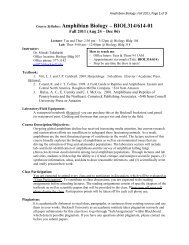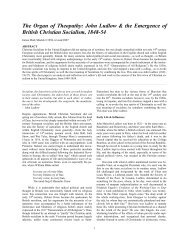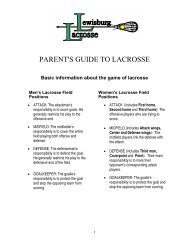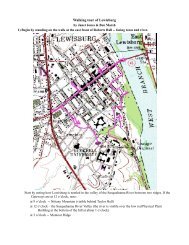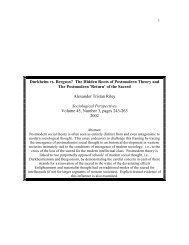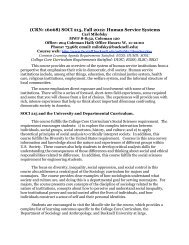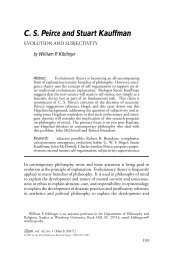Null expletives and the EPP in Slavic - Bucknell University
Null expletives and the EPP in Slavic - Bucknell University
Null expletives and the EPP in Slavic - Bucknell University
Create successful ePaper yourself
Turn your PDF publications into a flip-book with our unique Google optimized e-Paper software.
1 Introduction<br />
<strong>Null</strong> Expletives <strong>and</strong> <strong>the</strong> <strong>EPP</strong> <strong>in</strong> <strong>Slavic</strong>:<br />
A M<strong>in</strong>imalist Analysis<br />
James E. Lav<strong>in</strong>e Pr<strong>in</strong>ceton <strong>University</strong><br />
The purpose of this paper is to consider <strong>the</strong> status of null <strong>expletives</strong><br />
<strong>and</strong> <strong>the</strong> <strong>EPP</strong> <strong>in</strong> <strong>Slavic</strong> sentences lack<strong>in</strong>g a canonical NP subject. My<br />
central empirical claim is that under basic m<strong>in</strong>imalist assumptions, 1<br />
<strong>the</strong> properties of <strong>Slavic</strong> impersonals can be fully accounted for <strong>in</strong> an<br />
analysis that rejects null-<strong>expletives</strong>, but still recognizes <strong>EPP</strong> effects.<br />
The broader <strong>the</strong>oretical claim of this paper <strong>in</strong>volves <strong>the</strong> apparatus of<br />
<strong>the</strong> M<strong>in</strong>imalist Program itself: I will argue for a more direct<br />
relationship between <strong>the</strong> overt morphology <strong>in</strong> a given numeration <strong>and</strong><br />
<strong>the</strong> featural composition of <strong>the</strong> functional categories that this<br />
numeration projects. That is, I will argue that <strong>the</strong> presence of<br />
particular features <strong>in</strong> a functional head is not exhaustively determ<strong>in</strong>ed<br />
by <strong>the</strong> properties of <strong>the</strong> functional head itself, but by <strong>the</strong> particular<br />
morphology of <strong>the</strong> lexical items <strong>in</strong>volved <strong>in</strong> a derivation.<br />
The M<strong>in</strong>imalist Program presents a crucial departure from GB<br />
<strong>the</strong>ory that bears prom<strong>in</strong>ently on how grammatical relations such as<br />
subject (<strong>and</strong> thus <strong>the</strong> <strong>EPP</strong> <strong>in</strong> general) are understood. In GB <strong>the</strong>ory<br />
it was assumed that grammatical relations were closely l<strong>in</strong>ked to<br />
structural positions, which, <strong>in</strong> turn, were determ<strong>in</strong>ed by X-bar <strong>the</strong>ory.<br />
Grammatical relations are now reduced to check<strong>in</strong>g relations. In <strong>the</strong><br />
course of my analysis of <strong>the</strong> <strong>EPP</strong> <strong>in</strong> <strong>Slavic</strong>, I will show that <strong>the</strong><br />
notion of a unified subject position (i.e., [Spec, IP] <strong>in</strong> GB terms)<br />
crucially fails to account for <strong>the</strong> fact that <strong>the</strong> complex of traditional<br />
subject properties can be distributed over a sequence of positions <strong>in</strong><br />
an articulated INFL structure. In <strong>the</strong> present analysis, I will view<br />
subject-verb agreement, nom<strong>in</strong>ative Case assignment, <strong>and</strong> <strong>the</strong><br />
satisfaction of <strong>the</strong> so-called “<strong>EPP</strong>-feature” to consist of dist<strong>in</strong>ct<br />
check<strong>in</strong>g operations, unified by <strong>the</strong> spec-head relation.<br />
For helpful comments on earlier versions of this paper, I thank Leonard Babby,<br />
Robert Freid<strong>in</strong>, Stephanie Harves, <strong>and</strong> Edw<strong>in</strong> Williams. I also<br />
for comments he provided as <strong>the</strong> reviewer.<br />
1 See Chomsky 1995, as well as Ura 1996 <strong>and</strong> Thrá<strong>in</strong>sson 1996.
2<br />
The present paper will be organized <strong>in</strong> <strong>the</strong> follow<strong>in</strong>g way. In<br />
section 2 I will present some prelim<strong>in</strong>ary data <strong>and</strong> a sample<br />
derivation <strong>and</strong> structural representation. In section 3 I will provide a<br />
more <strong>in</strong> depth analysis of <strong>the</strong> data <strong>and</strong> provide cross-l<strong>in</strong>guistic<br />
<strong>in</strong>dependent motivation for <strong>the</strong> separation of <strong>the</strong> <strong>EPP</strong> <strong>and</strong> Case<br />
features. Sections 4 <strong>and</strong> 5 concern predicate agreement <strong>and</strong> null<br />
<strong>expletives</strong>.<br />
2 Data, Derivation <strong>and</strong> Structure<br />
(1) is <strong>the</strong> st<strong>and</strong>ard proposal for phrase structure <strong>in</strong> Chomsky 1995,<br />
ch. 3 (=MPLT):<br />
(1) [ AGRsP Spec AGRs [ TP Spec T [ AGRoP Spec AGRo [ VP DP [V DP]]]]]<br />
At <strong>the</strong> end of this section, I will modify (1) to conform to <strong>the</strong> specific<br />
morphological properties of <strong>the</strong> <strong>Slavic</strong> impersonals below <strong>in</strong> (3-9). 2<br />
My central claims with regard to <strong>the</strong> projection of phrase<br />
structure are summarized <strong>in</strong> (2) below:<br />
(2) Procedure for Project<strong>in</strong>g Phrase Structure <strong>and</strong> Featural<br />
Composition<br />
a. Project only those functional categories for which <strong>the</strong>re is overt<br />
morphological evidence <strong>in</strong> <strong>the</strong> numeration (see Thrá<strong>in</strong>sson 1996);<br />
b. Assume that <strong>the</strong> featural composition of heads is not universal,<br />
i.e., it is also determ<strong>in</strong>ed by overt morphological evidence<br />
We now consider <strong>the</strong> <strong>Slavic</strong> impersonals <strong>in</strong> (3-9). Here, as<br />
elsewhere <strong>in</strong> this paper, <strong>the</strong> focus is on East <strong>Slavic</strong> <strong>and</strong> Polish, where,<br />
2 I make use of <strong>the</strong> (Agr-less) multiple-spec structure proposed <strong>in</strong> Chomsky 1995, ch.<br />
4 (=Categories <strong>and</strong> Transformations) only <strong>in</strong> <strong>the</strong> case of <strong>the</strong> Old Russian example <strong>in</strong><br />
(14-15), where <strong>the</strong> features of <strong>the</strong> head, T, differ <strong>in</strong> terms of strength (see Ura 1996 on<br />
<strong>the</strong> <strong>the</strong>ory of multiple feature-check<strong>in</strong>g).
3<br />
with<strong>in</strong> <strong>Slavic</strong>, <strong>the</strong> peculiar configuration of impersonals with<br />
accusative arguments is most common (see Mrazek 1990:96-104). 3<br />
(3) Russian:<br />
ears: ACC PL clogged-up: N SG<br />
‘My ears clogged up.’<br />
b. *<br />
ears: NOM PL clogged-up: PL<br />
c.<br />
he PRT compla<strong>in</strong>ed at sniffles but clogged-up:NSG ears: ACC<br />
‘He kept compla<strong>in</strong><strong>in</strong>g of sniffles <strong>and</strong> <strong>the</strong>n his ears clogged up.’<br />
(4) Russian:<br />
Dux zaxvatilo<br />
breath: M ACC SG seized: N SG<br />
‘It took my breath away.’<br />
(5) (West) Ukra<strong>in</strong>ian:<br />
a.<br />
now this form: F ACC SG freely use: 3SG REFL <strong>in</strong> our language<br />
‘This form is now freely used <strong>in</strong> our language.’<br />
[Smere yns’kyj 1932:25]<br />
b.<br />
this form: F NOM SG use: 3SG REFL<br />
‘This form is now be<strong>in</strong>g freely used <strong>in</strong> our language.’<br />
use: 3SG REFL this form: F ACC SG<br />
3 I will use <strong>the</strong> term “impersonal” to refer to constructions that lack a nom<strong>in</strong>ative NP<br />
<strong>and</strong> subject-verb agreement.
(6) Ukra<strong>in</strong>ian:<br />
Bat’ka kole v boci<br />
fa<strong>the</strong>r: ACC SG pierce 3SG <strong>in</strong> side<br />
‘My fa<strong>the</strong>r has a sharp pa<strong>in</strong> <strong>in</strong> his side.’<br />
(7) Polish:<br />
a. Skargi przyjmuje w biurze<br />
compla<strong>in</strong>ts: ACC PL accept: 3SG REFL <strong>in</strong> office<br />
‘Compla<strong>in</strong>ts are taken <strong>in</strong> <strong>the</strong> office.’<br />
b. ???Skargi<br />
compla<strong>in</strong>ts: NOM PL accept: 3PL REFL<br />
c. ? Przyjmuje skargi w biurze<br />
accept: 3SG REFL compla<strong>in</strong>ts: ACC PL<br />
(8) Polish:<br />
4<br />
matter: ACC SG resolve: 3SG REFL<br />
‘Th<strong>in</strong>gs will work out.’<br />
(9) Czech:<br />
a.<br />
shorter words: GEN PL REFL use: 3SG more-often<br />
‘Shorter words are used more often.’<br />
b. *<br />
shorter words: NOM PL REFL use: 3PL<br />
c.<br />
use: 3SG REFL ra<strong>the</strong>r shorter words: GEN PL thanlonger<br />
‘Shorter words are used ra<strong>the</strong>r than longer ones.’<br />
An immediate observation is that <strong>the</strong> word order <strong>in</strong> <strong>the</strong> impersonal<br />
constructions <strong>in</strong> (3-9) entails a preverbal non-nom<strong>in</strong>ative NPconstituent.<br />
This word order is judged to be “discourse-neutral” by<br />
native speakers <strong>and</strong> occurs discourse-<strong>in</strong>itially. Thus I will argue that
5<br />
<strong>the</strong>se objects have not undergone topicalization to a special position<br />
(adjo<strong>in</strong>ed to IP accord<strong>in</strong>g to K<strong>in</strong>g 1995), but <strong>in</strong>stead are raised to<br />
satisfy <strong>the</strong> <strong>EPP</strong>, where <strong>the</strong> <strong>EPP</strong> position, <strong>in</strong> addition to lack<strong>in</strong>g a<br />
particular discourse function (see Babyonyshev 1996:13-27), is no<br />
longer associated with nom<strong>in</strong>ative Case or subject-verb agreement.<br />
Thus <strong>the</strong> structure of <strong>the</strong> impersonals <strong>in</strong> (3-9) should reflect <strong>the</strong><br />
fact that <strong>the</strong>se are non-agree<strong>in</strong>g predicates with a preverbal nonnom<strong>in</strong>ative<br />
DP. Accord<strong>in</strong>g to (2a), AGRsP will not be projected <strong>and</strong><br />
accord<strong>in</strong>g to (2b), T will lack a Case feature, mark<strong>in</strong>g this functional<br />
head as underspecified. The absence of a Case feature <strong>in</strong> T, which<br />
checks nom<strong>in</strong>ative Case when present, is crucial to this analysis<br />
because it allows impersonals to converge without a feature<br />
mismatch <strong>in</strong> TP (i.e., a DP marked accusative <strong>in</strong> a check<strong>in</strong>g<br />
configuration for nom<strong>in</strong>ative Case), result<strong>in</strong>g <strong>in</strong> a canceled derivation<br />
(Chomsky 1995:308-310). The fact that <strong>the</strong> numeration <strong>in</strong> each of<br />
<strong>the</strong> impersonals <strong>in</strong> (3-9) conta<strong>in</strong>s a DP will force <strong>the</strong> projection of a<br />
D-feature on T, which <strong>the</strong> syntactic evidence <strong>in</strong> <strong>the</strong> (a) sentences <strong>in</strong><br />
(3-9) suggests is strong. 4 In accordance with <strong>the</strong> movement<br />
operation Attract, 5 I will assume that <strong>in</strong> <strong>the</strong> (a) sentences <strong>in</strong> (3-9) <strong>the</strong><br />
strong D-feature on T is checked overtly by a raised argument which<br />
is <strong>in</strong>itially Merged as an <strong>in</strong>ternal argument of <strong>the</strong> verb. Note that <strong>the</strong><br />
accusative (or genitive) object <strong>in</strong> <strong>the</strong>se impersonals is <strong>the</strong> only<br />
available constituent whose D-feature can enter <strong>in</strong>to a check<strong>in</strong>g<br />
relation with T.<br />
As for those sentences <strong>in</strong> (3-9) which do not show OV word<br />
order, I will assume that <strong>the</strong> <strong>the</strong>me-rheme organization of <strong>the</strong><br />
sentence has superseded overt feature-driven movement, i.e., <strong>the</strong><br />
4<br />
The strong D-feature on T is <strong>the</strong> way <strong>in</strong> which <strong>the</strong> <strong>EPP</strong> is formulated <strong>in</strong> <strong>the</strong><br />
M<strong>in</strong>imalist Program.<br />
5<br />
Attract is formulated <strong>the</strong> follow<strong>in</strong>g way (Chomsky 1995:297, slightly modified):<br />
“A functional category attracts <strong>the</strong> feature F if F is <strong>the</strong> closest feature that can enter<br />
<strong>in</strong>to a check<strong>in</strong>g relation with its head.” Thus, strictly speak<strong>in</strong>g, Attract operates on<br />
features only. For overt movement, I will assume “generalized pied-pip<strong>in</strong>g” of <strong>the</strong><br />
lexical material associated with <strong>the</strong> raised D-feature <strong>in</strong> order to satisfy <strong>in</strong>terface<br />
conditions at PF: <strong>the</strong> D-feature itself cannot be pronounced <strong>and</strong>, thus, at PF is<br />
un<strong>in</strong>terpretable.
6<br />
object <strong>in</strong> <strong>the</strong>se sentences is obligatorily rhematic. 6 Theme-rheme<br />
structure can be considered part of <strong>the</strong> phonological component,<br />
which affects <strong>the</strong> surface syntax (see Chomsky 1995:343). 7 I will<br />
return to <strong>in</strong>stances of <strong>the</strong> object appear<strong>in</strong>g post-verbally <strong>in</strong> section 2.<br />
In (10) I give <strong>the</strong> derivation for (3a) <strong>and</strong> <strong>in</strong> (11), below, I give its<br />
structural representation. The o<strong>the</strong>r examples of impersonals with<br />
pre-verbal accusative DPs should have a similar derivation <strong>and</strong><br />
representation.<br />
(10) : Derivation<br />
Merge D, V = [ VP [ V [ D ]]]<br />
Merge VP, AGRo = [ AGRoP AGRo [ VP [ V [ D ]]]]<br />
(motivated by <strong>the</strong> ACC Case on i)<br />
Merge AGRoP, T =<br />
[ TP T [ AGRoP AGRo [ VP [ V [ D ]]]]]<br />
(motivated by <strong>the</strong> Tense feature on o)<br />
(overtly) Move D to [Spec, TP] =<br />
[ TP T [ AGRoP AGRo [ VP [ V [ D t i ]]]]]<br />
(by Attract: <strong>the</strong> D-feature (plus <strong>the</strong> lexical material associated<br />
with it) raises to check <strong>the</strong> <strong>EPP</strong> <strong>in</strong> [Spec, TP])<br />
(covertly) Move AGRo + V to T =<br />
[ TP T [ AGRo t j [ VP [ V t k [ D t i ]]]]]<br />
(ACC Case on is checked aga<strong>in</strong>st <strong>the</strong> AGRo + V + T complex<br />
head)<br />
6 The possibility of <strong>the</strong>me-rheme structure affect<strong>in</strong>g feature-check<strong>in</strong>g, <strong>in</strong> <strong>the</strong> present<br />
case delay<strong>in</strong>g it until after spell-out, has not been discussed <strong>in</strong> <strong>the</strong> literature as far as I<br />
know. Here I provide only an <strong>in</strong>itial formulation which will have to be ref<strong>in</strong>ed <strong>in</strong><br />
future research.<br />
7 Babby 1980 demonstrates clear syntactic effects of <strong>the</strong>me-rheme structure on <strong>the</strong><br />
basis of an entirely different set of data.
(11) : Structural Representation<br />
TP<br />
Spec T’<br />
7<br />
T AGRoP<br />
AGRo VP<br />
V DP<br />
Note that <strong>the</strong> normal check<strong>in</strong>g configuration for <strong>the</strong> accusative<br />
argument never occurs: due to <strong>the</strong> lack of overt Verb-Movement to<br />
AGRo (<strong>and</strong> <strong>the</strong>n to T) <strong>in</strong> Russian <strong>and</strong> <strong>the</strong> o<strong>the</strong>r <strong>Slavic</strong> languages that<br />
we are consider<strong>in</strong>g (See Bailyn 1995 on Russian), <strong>the</strong> direct object<br />
cannot have its accusative Case checked overtly <strong>in</strong> [Spec, AGRoP].<br />
Here I assume Holmberg’s generalization which states that overt<br />
object rais<strong>in</strong>g is cont<strong>in</strong>gent on overt verb rais<strong>in</strong>g. The lack of overt<br />
object rais<strong>in</strong>g allows us to propose an AGRoP with no Specifier. As<br />
a result, <strong>the</strong> object DP can raise overtly to [Spec, TP] with no<br />
violation of Shortest Move: <strong>the</strong> moved element has not skipped an<br />
appropriate l<strong>and</strong><strong>in</strong>g site. The complex head AGRo + V adjo<strong>in</strong>s to T<br />
at LF where V (<strong>in</strong> conjunction with AGRo) checks accusative Case<br />
on <strong>the</strong> object DP <strong>in</strong> a spec-head relation. 8<br />
8 Note however that AGRo is only <strong>in</strong>directly <strong>in</strong>volved <strong>in</strong> <strong>the</strong> check<strong>in</strong>g of accusative<br />
case morphology, i.e., <strong>the</strong> accusative Case feature itself is an N-feature of V. In <strong>the</strong><br />
impersonal predicates we are consider<strong>in</strong>g, <strong>the</strong>re are two factors which may allow <strong>the</strong><br />
nonprojection of AGRoP: i) <strong>the</strong>re is no object agreement with <strong>the</strong> predicate; <strong>and</strong> ii)<br />
<strong>the</strong> accusative Case of <strong>the</strong> object can be checked elsewhere, namely, wherever V<br />
adjo<strong>in</strong>s to a functional head whose specifier can host <strong>the</strong> accusative argument. If T<br />
lacks its usual (nom<strong>in</strong>ative) Case feature <strong>in</strong> such predicates, as I have suggested<br />
above, <strong>the</strong> possibility arises for <strong>the</strong> accusative Case feature to be checked (post-<br />
Spell-Out) <strong>in</strong> its (i.e., T’s) specifier. It will be recalled that <strong>the</strong> accusative object<br />
already moves to [Spec, TP] overtly to check <strong>the</strong> <strong>EPP</strong> feature; V moves <strong>in</strong>dependently
3 Analysis<br />
3.1 The Data<br />
8<br />
The basic facts regard<strong>in</strong>g (3-4) were discussed above. I will return<br />
to (3c) shortly. The Ukra<strong>in</strong>ian <strong>and</strong> Polish examples <strong>in</strong> (5) <strong>and</strong> (7-8)<br />
demonstrate impersonalization as a productive process associated<br />
with affixation, <strong>in</strong> contrast to <strong>the</strong> type of impersonal predicate <strong>in</strong> (3-<br />
4) <strong>and</strong> (6) which is limited <strong>in</strong> Russian <strong>and</strong> Ukra<strong>in</strong>ian to a relatively<br />
small number of lexical items. In (5) <strong>and</strong> (7-8), as well as <strong>in</strong> Czech<br />
(9), <strong>the</strong> reflexive morpheme is function<strong>in</strong>g <strong>in</strong> a voice-alter<strong>in</strong>g<br />
capacity. In Ukra<strong>in</strong>ian <strong>and</strong> Polish <strong>the</strong> reflexive morpheme shares <strong>the</strong><br />
lexical property of optionally project<strong>in</strong>g AGRsP; i.e., <strong>the</strong> verb may<br />
optionally merge with an accusative object or a nom<strong>in</strong>ative subject.<br />
In <strong>the</strong> impersonals <strong>in</strong> (5) <strong>and</strong> (7-8), when AGRsP is not projected, it<br />
follows that <strong>the</strong>re will be no subject-verb agreement <strong>and</strong> T will be<br />
deprived of its Case feature. The result<strong>in</strong>g form <strong>in</strong> both languages is<br />
a middle. 9 In <strong>the</strong> personal (b) sentences <strong>in</strong> (5) <strong>and</strong> (7), AGRsP is<br />
projected as well as <strong>the</strong> Case feature on T to check nom<strong>in</strong>ative. The<br />
Ukra<strong>in</strong>ian example <strong>in</strong> (5b) is a canonical passive. The Polish<br />
example <strong>in</strong> (7b) is quite marg<strong>in</strong>al; <strong>the</strong> permissibility of subject-verb<br />
agreement for such Polish expressions with <strong>the</strong> reflexive morpheme<br />
(i.e., for middles ra<strong>the</strong>r than for pure reflexives) depends on <strong>the</strong><br />
semantics of <strong>the</strong> VP, an issue I will not pursue here (see Dziwirek<br />
1994). The Ukra<strong>in</strong>ian example <strong>in</strong> (5c), where <strong>the</strong> accusative object<br />
appears post-verbally, is readily <strong>in</strong>terpretable, but <strong>in</strong>felicitous <strong>in</strong> a<br />
discourse-neutral sett<strong>in</strong>g.<br />
Note that <strong>in</strong> (9a) <strong>the</strong>re is no accusative Case check<strong>in</strong>g; <strong>the</strong> verb<br />
here, assigns lexical Case. Though <strong>the</strong> oblique object can<br />
still raise by Attract to check <strong>the</strong> strong D-feature on T, <strong>the</strong> way <strong>in</strong><br />
which its Case is assigned may differ from <strong>the</strong> o<strong>the</strong>r examples.<br />
Chomsky 1995 (ch. 4) argues that only structural case is checked.<br />
Lexical (or <strong>in</strong>herent) Case is <strong>in</strong>terpretable <strong>and</strong> thus need not enter a<br />
to T (post-Spell-Out) to check Tense. Thus, a maximally simple alternative structure<br />
for (11) is: [ TP DP i T [ VP V [ t i ]]].<br />
9 See Lav<strong>in</strong>e 1997 for more on <strong>the</strong> voice properties of such constructions.
9<br />
check<strong>in</strong>g relation. This argument has been challenged by<br />
1997, follow<strong>in</strong>g Lasnik 1995, where <strong>the</strong> bearer of lexical case is<br />
shown to raise out of VP to enter a check<strong>in</strong>g relation <strong>in</strong> <strong>the</strong> usual<br />
way. At this po<strong>in</strong>t <strong>in</strong> <strong>the</strong> analysis, it is not necessary to take a<br />
position on <strong>the</strong> way <strong>in</strong> which lexical Case is treated. My sole claim <strong>in</strong><br />
(9a) is that regardless of Case, <strong>the</strong> DP raises to [Spec,<br />
TP] where it checks <strong>the</strong> strong D-feature on T.<br />
As a f<strong>in</strong>al note on <strong>the</strong> data <strong>in</strong> (3-9), I want to clarify that <strong>the</strong> OV<br />
surface word order is by no means obligatory. In (3c) <strong>and</strong> (9c) I<br />
have <strong>in</strong>dicated a fully acceptable alternate word order. These are<br />
examples of contrastive focus, where <strong>the</strong> focused (i.e., rhematic)<br />
constituent ( i <strong>in</strong> (3c) <strong>and</strong> <strong>in</strong> (9c)) is post-verbal <strong>and</strong>,<br />
<strong>in</strong> <strong>the</strong> Russian example, marked by neutral (fall<strong>in</strong>g) <strong>in</strong>tonation.<br />
3.2 Cross-l<strong>in</strong>guistic Motivation for <strong>the</strong> Separation of <strong>the</strong> <strong>EPP</strong> <strong>and</strong><br />
Case Features<br />
The existence of constructions <strong>in</strong> which an object acquires <strong>the</strong><br />
positional property of subject without <strong>the</strong> associated Case mark<strong>in</strong>g<br />
has long been observed <strong>in</strong> <strong>the</strong> “pre-<strong>the</strong>oretical” descriptive<br />
literature. Keenan 1976 notes examples of such “<strong>in</strong>verse<br />
constructions” <strong>in</strong> Biblical Hebrew, <strong>and</strong> Saharan <strong>and</strong> Bantu<br />
languages. The <strong>in</strong>tuition that languages can split subject functions<br />
such as <strong>the</strong> traditional positional constra<strong>in</strong>t <strong>and</strong> nom<strong>in</strong>ative Case is<br />
confirmed by recent research with<strong>in</strong> <strong>the</strong> M<strong>in</strong>imalist Program. Jonas<br />
1996 demonstrates <strong>the</strong> <strong>in</strong>dependent check<strong>in</strong>g relations of <strong>the</strong> <strong>EPP</strong><br />
<strong>and</strong> Case features <strong>in</strong> Icel<strong>and</strong>ic Transitive Expletive Constructions<br />
(TECs), such as (12) :<br />
(12) Icel<strong>and</strong>ic TEC at Spell-Out<br />
[ AGRsP j [ TP i [ AGRoP k [ VP t i t j t k ]]]]<br />
<strong>the</strong>re pa<strong>in</strong>ted foreigner <strong>the</strong>-house<br />
‘A foreigner pa<strong>in</strong>ted <strong>the</strong> house.’
10<br />
Here, <strong>the</strong> lexical subject checks its Case feature (at LF) <strong>in</strong> [Spec, TP],<br />
while a productive overt expletive checks <strong>the</strong> <strong>EPP</strong> feature <strong>in</strong> [Spec,<br />
AGRsP]. 10<br />
St<strong>and</strong>ard English ECM constructions also provide evidence for<br />
<strong>EPP</strong>-satisfaction <strong>in</strong>dependent of Case. (13) is from Lasnik 1995:<br />
(13) English ECM Construction<br />
I believe [someone to be [t here]].<br />
Note that movement of ‘someone’ to <strong>the</strong> embedded subject position<br />
is driven by <strong>the</strong> strong D-feature on <strong>the</strong> embedded non-f<strong>in</strong>ite T.<br />
There is no o<strong>the</strong>r feature to attract it; <strong>the</strong> specifier of <strong>the</strong> embedded<br />
TP is not a Case position. The accusative Case of ‘someone’ is<br />
subsequently checked <strong>in</strong> <strong>the</strong> usual fashion by movement to <strong>the</strong><br />
[Spec, AGRoP] of <strong>the</strong> matrix verb. Follow<strong>in</strong>g <strong>the</strong> assumption that<br />
<strong>the</strong> N-features of AGRo <strong>in</strong> English are weak, this movement must be<br />
covert by Procrast<strong>in</strong>ate (see Lasnik 1995:621-624 <strong>and</strong> Chomsky<br />
1995:345-346 for discussion). 11<br />
10 Jonas (personal communication) suggests that <strong>the</strong> <strong>EPP</strong> feature is not universally<br />
conta<strong>in</strong>ed <strong>in</strong> T, but may be hosted by o<strong>the</strong>r functional heads. Note <strong>in</strong> <strong>the</strong> Icel<strong>and</strong>ic<br />
TEC <strong>in</strong> (12) that <strong>the</strong> strong D-feature responsible for <strong>EPP</strong> effects is hosted by AGRs.<br />
The [Spec, TP] position <strong>in</strong> Icel<strong>and</strong>ic appears to be associated with a particular<br />
discourse <strong>in</strong>terpretation, namely <strong>in</strong>def<strong>in</strong>iteness (Jonas 1996:168-169, 178-181),<br />
which drives <strong>the</strong> movement of <strong>the</strong> lexical subject.<br />
11 An alternate analysis which accounts for ECM facts based on Greed, ra<strong>the</strong>r than<br />
Attract, is proposed <strong>in</strong> 1997. Under a strict <strong>in</strong>terpretation of Greed, namely<br />
that only <strong>the</strong> morphological requirements of <strong>the</strong> moved item can provide <strong>the</strong> driv<strong>in</strong>g<br />
force for movement, argues that <strong>the</strong> embedded subject someone cannot<br />
move to satisfy <strong>the</strong> <strong>EPP</strong> feature alone: such movement would be “altruistic.” Instead,<br />
<strong>the</strong> embedded subject moves overtly to <strong>the</strong> matrix [Spec, AGRoP], where it checks its<br />
own Case feature. See 1997:105-124 for <strong>the</strong> details of his analysis.<br />
The effect of <strong>the</strong> <strong>EPP</strong> is more conv<strong>in</strong>c<strong>in</strong>gly isolated <strong>in</strong> rais<strong>in</strong>g structures that do not<br />
conta<strong>in</strong> a potential Case-marked position for <strong>the</strong> embedded subject to move <strong>in</strong>to.<br />
Note <strong>the</strong> Icel<strong>and</strong>ic Rais<strong>in</strong>g Expletive Construction below, where <strong>the</strong> matrix verb does<br />
not assign accusative Case (i.e., <strong>the</strong>re is no matrix AGRoP projection):<br />
(i) [ [ ]]<br />
<strong>the</strong>re seem many men to-be <strong>in</strong> <strong>the</strong>-room<br />
‘Many men seem to be <strong>in</strong> <strong>the</strong> room.’ [Jonas 1996:169]
11<br />
The f<strong>in</strong>al support<strong>in</strong>g evidence that I will <strong>in</strong>troduce to demonstrate<br />
that <strong>the</strong> <strong>EPP</strong> can be checked <strong>in</strong>dependently is <strong>the</strong> nom<strong>in</strong>ative object<br />
construction <strong>in</strong> Old Russian, as illustrated <strong>in</strong> (14):<br />
(14) Old Russian (OR) Nom<strong>in</strong>ative Object Construction<br />
Korolju bylo ta ruxljad’ dati<br />
k<strong>in</strong>g: M DAT was: N that property: F NOM give: INF<br />
‘It was for <strong>the</strong> k<strong>in</strong>g to give back that property.’<br />
[Timberlake 1974]<br />
In this example T’s D-feature is checked overtly by an oblique DP<br />
while its Case feature is checked <strong>in</strong> <strong>the</strong> covert (post-Spell-Out)<br />
syntax by <strong>the</strong> nom<strong>in</strong>ative object. 12 Thus (14) presents <strong>the</strong> logical<br />
possibility that two features of a functional head may vary with<br />
respect to strength. Here, follow<strong>in</strong>g Ura 1996, I will argue that T<br />
enters <strong>in</strong>to multiple feature-check<strong>in</strong>g relations, i.e., <strong>the</strong> <strong>in</strong>dependent<br />
check<strong>in</strong>g of particular “subject functions,” necessitat<strong>in</strong>g <strong>the</strong><br />
multiple-Spec structure proposed <strong>in</strong> Chomsky 1995, ch. 4 (§10).<br />
Follow<strong>in</strong>g <strong>the</strong> modified “Categories <strong>and</strong> Transformations” phrase<br />
structure, <strong>the</strong> dative subject is merged <strong>in</strong> its <strong>the</strong>ta-position <strong>in</strong> <strong>the</strong> Spec<br />
of <strong>the</strong> “light verb” projection, vP. 13 Follow<strong>in</strong>g Babby 1997, I will<br />
treat <strong>the</strong> dative mark<strong>in</strong>g on <strong>the</strong> subject of <strong>the</strong> <strong>in</strong>f<strong>in</strong>itive as lexical<br />
(<strong>in</strong>herent) Case assigned by <strong>the</strong> <strong>in</strong>f<strong>in</strong>itival affix on <strong>the</strong> lexical verb.<br />
At this po<strong>in</strong>t I will fur<strong>the</strong>r adopt <strong>the</strong> m<strong>in</strong>imalist assumption that<br />
lexical case enters <strong>the</strong> derivation [+<strong>in</strong>terpretable]. In accordance with<br />
<strong>the</strong> procedure I assume <strong>in</strong> (2b) for project<strong>in</strong>g <strong>the</strong> featural<br />
composition on functional heads, light v will not have its usual<br />
(accusative) Case feature, <strong>and</strong> T, <strong>in</strong> <strong>the</strong> absence of subject-verb<br />
agreement, will not have phi-features to be checked. Factor<strong>in</strong>g out<br />
movement of <strong>the</strong> copula (which does not obligatorily appear <strong>in</strong> such<br />
Old Russian constructions), <strong>the</strong> follow<strong>in</strong>g structure obta<strong>in</strong>s:<br />
12<br />
I assume that <strong>the</strong> preverbal position of <strong>the</strong> object ta ruxljad’ is a result of its<br />
<strong>the</strong>matic discourse status.<br />
13<br />
Follow<strong>in</strong>g Chomsky 1995, ch. 4, v is <strong>the</strong> higher head of a layered VP-shell for<br />
transitive verbs.
12<br />
(15) OR Nom<strong>in</strong>ative Object Construction<br />
4 Agreement<br />
[ TP Korolju i [ ta ruxljad’ k [ T [ vP t i [ v [ VP dati t k ]]]]]]<br />
D-feature Case feature<br />
I now turn to <strong>the</strong> question of agreement morphology on <strong>the</strong><br />
impersonals <strong>in</strong> (3-9). The <strong>in</strong>variable 3 neut sg verb form is generally<br />
expla<strong>in</strong>ed <strong>in</strong> one of two ways: 1) as <strong>the</strong> default verbal morphology <strong>in</strong><br />
<strong>Slavic</strong> for non-agree<strong>in</strong>g predicates; or 2) as ord<strong>in</strong>ary subject-verb<br />
agreement with a null expletive, which is presumed to be neut sg as<br />
well. 14 Before discuss<strong>in</strong>g an alternative analysis of <strong>the</strong> <strong>in</strong>flectional<br />
morphology <strong>in</strong> (3-9), I will broaden <strong>the</strong> sample of data to <strong>in</strong>clude<br />
personal variants of <strong>the</strong> Russian impersonals <strong>in</strong> (3-4):<br />
(16) Russian (cf. (3)):<br />
mo<strong>the</strong>r: F NOM stuffed: F child: DAT cotton: ACC <strong>in</strong> ear<br />
‘The mo<strong>the</strong>r stuffed cotton <strong>in</strong> her child’s ear.’<br />
(17) Russian (cf. (4)):<br />
Nemcy zaxvatili Pragu<br />
Germans: NOM PL seized: PL Prague: ACC<br />
‘The Germans seized Prague.’<br />
14 <strong>Null</strong> <strong>expletives</strong> have been posited for <strong>Slavic</strong> impersonals by various researchers<br />
<strong>in</strong>clud<strong>in</strong>g Sob<strong>in</strong> 1985, Kipka 1989, Franks 1995 <strong>and</strong> Schoorlemmer 1995. Note that<br />
null <strong>expletives</strong> are argued to account not only for <strong>the</strong> agreement morphology on <strong>the</strong><br />
verb, but also for <strong>the</strong> <strong>EPP</strong> <strong>in</strong> sentences lack<strong>in</strong>g a canonical (nom<strong>in</strong>ative) subject. By<br />
divorc<strong>in</strong>g <strong>the</strong> strict requirement of nom<strong>in</strong>ative Case from <strong>EPP</strong>-satisfaction, we have<br />
seen how <strong>the</strong> <strong>EPP</strong>-feature can be checked by a predicate’s <strong>in</strong>ternal argument. As for<br />
subject-verb agreement, I will argue that <strong>Slavic</strong> impersonals exhibit no<br />
morphological evidence for project<strong>in</strong>g <strong>the</strong> AGRsP category, where subject-verb<br />
agreement ord<strong>in</strong>arily takes place.
13<br />
The agree<strong>in</strong>g predicates <strong>in</strong> (16-17) demonstrate an alternation <strong>in</strong> <strong>the</strong><br />
way <strong>in</strong> which <strong>the</strong> verb Merges. To pursue an explanation of such an<br />
alternation, I will now turn to <strong>the</strong> impersonal neut sg morphology<br />
itself. The notion of “default morphology” is not an explanation <strong>in</strong><br />
m<strong>in</strong>imalist terms. It suggests that <strong>the</strong> predicate “looks ahead” at <strong>the</strong><br />
result<strong>in</strong>g syntactic configuration <strong>and</strong> <strong>the</strong>n accord<strong>in</strong>gly selects nonagree<strong>in</strong>g<br />
morphology. Accord<strong>in</strong>g to m<strong>in</strong>imalist assumptions,<br />
follow<strong>in</strong>g <strong>the</strong> assumptions of <strong>the</strong> Strong Lexicalist Hypo<strong>the</strong>sis (or<br />
what Di Sciullo <strong>and</strong> Williams 1987 refer to as “Syntactic<br />
Atomicity”), items are selected from <strong>the</strong> lexicon fully-<strong>in</strong>flected. The<br />
syntax is projected based on <strong>the</strong> morphological features of <strong>the</strong><br />
selected lexical items, <strong>and</strong> not vica versa.<br />
Follow<strong>in</strong>g Babby 1996, I will argue that <strong>in</strong>flectional morphology<br />
<strong>in</strong> its non-canonical use (i.e., when not mark<strong>in</strong>g agreement)<br />
systematically affects Argument Structure. The neuter s<strong>in</strong>gular<br />
end<strong>in</strong>g <strong>in</strong> its non-canonical use is lexically stipulated to show no<br />
subject-verb agreement. In m<strong>in</strong>imalist terms, after Merg<strong>in</strong>g with a<br />
complement, a verb with this type of morphology immediately<br />
proceeds to target AGRo, as <strong>in</strong> <strong>the</strong> derivation <strong>in</strong> (10); a subject<br />
position with<strong>in</strong> VP as <strong>in</strong> (1) is not projected. In accordance with (2a),<br />
<strong>the</strong> functional category AGRsP, where subject-verb agreement is<br />
checked, will also not be projected, <strong>and</strong> <strong>the</strong> verb itself, <strong>in</strong> accordance<br />
with (2b), will lack its usual phi-features. 15 In such a case, if a<br />
subject NP were projected, it would have to raise to a [Spec, AGRsP]<br />
position where agreement would fail <strong>and</strong> <strong>the</strong> derivation would crash.<br />
In contrast, <strong>in</strong> <strong>the</strong> agree<strong>in</strong>g predicates <strong>in</strong> (16-17), <strong>the</strong> verb (+<br />
complement) must Merge with a subject <strong>and</strong> ultimately target<br />
AGRsP because <strong>the</strong> [-<strong>in</strong>terpretable] phi-features that agree<strong>in</strong>g verbs<br />
conta<strong>in</strong> must be checked.<br />
Independent evidence for a separate non-agree<strong>in</strong>g affix, dist<strong>in</strong>ct<br />
from neut sg morphology, is found <strong>in</strong> <strong>the</strong> Polish impersonal /<br />
personal passive participle alternation. In (18), <strong>the</strong> non-agree<strong>in</strong>g<br />
15 The 3 neut sg end<strong>in</strong>g -o is thus best treated as derivational, ra<strong>the</strong>r than <strong>in</strong>flectional,<br />
morphology s<strong>in</strong>ce it directly affects predicate Argument Structure <strong>and</strong> is not <strong>in</strong>volved<br />
<strong>in</strong> agreement. This makes <strong>the</strong> lack of phi-features on impersonal verbs a completely<br />
predictable property.
14<br />
impersonal affix -o <strong>in</strong> <strong>the</strong> (a) sentence is contrasted with agree<strong>in</strong>g -e<br />
<strong>in</strong> <strong>the</strong> (c) sentence:<br />
(18) Polish Impersonal vs. Personal Participial Predicate<br />
a. Impersonal Passive<br />
b. *<br />
wheat: F ACC sowed: IMPERS always <strong>in</strong>-fall<br />
‘Wheat was always sowed <strong>in</strong> <strong>the</strong> fall.’<br />
c. Personal Passive<br />
child: N NOM was loved: N SG by mo<strong>the</strong>r: ACC<br />
‘The child was loved by <strong>the</strong> mo<strong>the</strong>r.’<br />
[Dziwirek 1994:182-185]<br />
Note that <strong>in</strong> <strong>the</strong> Polish adjectival (participial) declension, -o is a<br />
dist<strong>in</strong>ct derivational morpheme 16 whose sole function is to mark<br />
impersonal predicates. In (18b) we see that <strong>the</strong> neut sg affix (-e)<br />
cannot project an impersonal, but agrees with neut sg subjects as <strong>in</strong><br />
<strong>the</strong> canonical passive <strong>in</strong> (18c). When <strong>the</strong> neut sg end<strong>in</strong>g does not<br />
differ phonologically from <strong>the</strong> non-agree<strong>in</strong>g impersonal end<strong>in</strong>g, <strong>the</strong><br />
two <strong>in</strong>flections must be considered separate homophonous<br />
end<strong>in</strong>gs. 17<br />
16 The Polish <strong>and</strong> Ukra<strong>in</strong>ian -o <strong>in</strong> -no/-to constructions was <strong>in</strong>itially <strong>the</strong> neut sg<br />
<strong>in</strong>flectional end<strong>in</strong>g <strong>in</strong> <strong>the</strong> nom<strong>in</strong>al (i.e., short form) declension of adjectives. With<br />
<strong>the</strong> loss of <strong>the</strong> nom<strong>in</strong>al declension of adjectives <strong>in</strong> <strong>the</strong>se languages, <strong>in</strong>flectional -o<br />
was reanalyzed as belong<strong>in</strong>g to <strong>the</strong> derivational stem to form a new unchang<strong>in</strong>g<br />
predicate category. For a general account of <strong>the</strong> history of -no/-to constructions see<br />
Brajerski 1979 for Polish <strong>and</strong> Shevelov 1969 for Ukra<strong>in</strong>ian.<br />
17 Thus <strong>the</strong> neuter s<strong>in</strong>gular gloss <strong>in</strong> (3-4), as well as <strong>in</strong> (19-21) below, may be best<br />
marked as IMPERS(onal), as <strong>in</strong> (18a).
5 <strong>Null</strong> Expletives<br />
15<br />
In <strong>the</strong> previous section we addressed <strong>the</strong> problem of agreement <strong>in</strong><br />
impersonal predicates. In <strong>the</strong> absence of a functional projection for<br />
subject-predicate agreement, <strong>the</strong> role of null <strong>expletives</strong> is sharply<br />
reduced. Fur<strong>the</strong>rmore, by separat<strong>in</strong>g <strong>the</strong> <strong>EPP</strong> from <strong>the</strong> nom<strong>in</strong>ative<br />
Case, we saw that null <strong>expletives</strong> need not be <strong>in</strong>voked to check <strong>the</strong><br />
<strong>EPP</strong>-feature on T. 18<br />
Accord<strong>in</strong>g to <strong>the</strong> present analysis, <strong>the</strong> <strong>EPP</strong> is satisfied by <strong>the</strong><br />
operation Attract on <strong>the</strong> verb’s sole <strong>in</strong>ternal argument. It should be<br />
borne <strong>in</strong> m<strong>in</strong>d that null <strong>expletives</strong> are semantically vacuous: <strong>the</strong>y<br />
conta<strong>in</strong> only <strong>the</strong> categorial D-feature. The question is: do we need<br />
this D-feature? The claim <strong>in</strong> this paper is that <strong>in</strong>vok<strong>in</strong>g null<strong>expletives</strong><br />
to account for non-agree<strong>in</strong>g impersonal predicates<br />
amounts to <strong>in</strong>troduc<strong>in</strong>g a D-feature <strong>in</strong>to a derivation where its effect<br />
is already <strong>in</strong>dependently accounted for.<br />
18 The question of overt <strong>expletives</strong> <strong>in</strong> <strong>Slavic</strong> is discussed <strong>in</strong> Bill<strong>in</strong>gs 1993 <strong>and</strong> Franks<br />
1995. In Ukra<strong>in</strong>ian, for example, both Bill<strong>in</strong>gs <strong>and</strong> Franks argue that <strong>the</strong> neuter<br />
s<strong>in</strong>gular pronoun vono may function as an expletive <strong>in</strong> impersonal sentences, fill<strong>in</strong>g<br />
an o<strong>the</strong>rwise open subject position. The follow<strong>in</strong>g example is cited <strong>in</strong> both sources:<br />
(i) Vono b ne vadylo s’ohodni pohuljaty<br />
PRT NEG harm: N SG today take-a-walk<br />
‘It would do no harm to go for a walk today.’<br />
This <strong>in</strong>deed would suggest an alternate strategy for satisfy<strong>in</strong>g <strong>the</strong> <strong>EPP</strong> than <strong>the</strong> one<br />
proposed <strong>in</strong> this paper; however, treat<strong>in</strong>g Ukra<strong>in</strong>ian vono as a place-holder for<br />
unfilled subjects is not unproblematic. First note that vono <strong>in</strong> (i) is optional <strong>and</strong>, <strong>in</strong><br />
fact, judged by my <strong>in</strong>formants as marg<strong>in</strong>al. Note also that vono is not used <strong>in</strong> wea<strong>the</strong>r<br />
verbs such as those below <strong>in</strong> (19-21) <strong>in</strong> contrast to English it or German es:<br />
(ii) (*Vono) sutenije<br />
grow<strong>in</strong>g-dark: 3SG<br />
‘It is grow<strong>in</strong>g dark.’<br />
F<strong>in</strong>ally, <strong>the</strong>re is no evidence that vono takes part <strong>in</strong> <strong>the</strong> expletive-associate<br />
constructions described <strong>in</strong> Chomsky 1995:340-348. Chomsky suggests that<br />
expletive constructions alternate with nonexpletive constructions to affect a<br />
difference <strong>in</strong> <strong>in</strong>terpretation between overt rais<strong>in</strong>g of a subject (<strong>in</strong> <strong>the</strong> case of<br />
nonexpletive constructions) <strong>and</strong> <strong>the</strong> covert rais<strong>in</strong>g of its features (<strong>in</strong> expletive<br />
constructions). S<strong>in</strong>ce <strong>Slavic</strong> organizes <strong>the</strong>me-rheme structure by means of<br />
scrambl<strong>in</strong>g, expletive-associate constructions, by hypo<strong>the</strong>sis, should be<br />
unmotivated.
16<br />
A f<strong>in</strong>al question concerns <strong>the</strong> null-expletive proposal for<br />
impersonals of <strong>the</strong> “wea<strong>the</strong>r verb” type, as <strong>in</strong> (19-21):<br />
(19) Russian:<br />
Stemnelo<br />
grew-dark: N SG<br />
‘It grew dark.’<br />
(20) Polish:<br />
cleared-up: N SG REFL<br />
‘It cleared up.’<br />
(21) Czech:<br />
thundered: N SG<br />
‘It thundered.’<br />
To determ<strong>in</strong>e <strong>the</strong> structure for <strong>the</strong>se expressions, I refer back to (2)<br />
for <strong>the</strong> projection of phrase structure <strong>and</strong> featural composition of<br />
functional heads. Accord<strong>in</strong>g to (2a) <strong>the</strong>re will be no AGR<br />
projections. T will be projected to check <strong>the</strong> Tense feature of <strong>the</strong> verb<br />
but, <strong>in</strong> accordance with (2b), will not conta<strong>in</strong> a D-feature.<br />
Un<strong>in</strong>terpretable features appear <strong>in</strong> <strong>the</strong> syntax only <strong>in</strong> relation to <strong>the</strong><br />
morphological properties found <strong>in</strong> <strong>the</strong> numeration. Thus, <strong>in</strong> (19-21)<br />
my claim is that <strong>the</strong> T projected by <strong>the</strong> “wea<strong>the</strong>r verbs” is even more<br />
underspecified: not only does it lack a Case feature, as <strong>in</strong> <strong>the</strong> o<strong>the</strong>r<br />
impersonals we have analyzed, but it also lacks a D-feature to attract<br />
nom<strong>in</strong>al material. 19 The claim, <strong>the</strong>n, is not that all <strong>Slavic</strong> sentences<br />
strictly adhere to <strong>the</strong> <strong>EPP</strong>, but <strong>in</strong>stead that <strong>the</strong> D-feature on T, if<br />
projected, is strong, <strong>and</strong> by <strong>the</strong> operation Attract, will <strong>in</strong>duce <strong>the</strong><br />
rais<strong>in</strong>g of an impersonal’s <strong>in</strong>ternal argument.<br />
19 The option of “relativiz<strong>in</strong>g” <strong>the</strong> specification of T’s D-feature appears to be<br />
possible only <strong>in</strong> nonexpletive languages (cf. English: *Is ra<strong>in</strong><strong>in</strong>g). I thank<br />
for br<strong>in</strong>g<strong>in</strong>g this problem to my attention.
6 Conclusion<br />
17<br />
In <strong>the</strong> present analysis I have argued for what can be labeled a<br />
lexicalist application of <strong>the</strong> m<strong>in</strong>imalist apparatus. All elements of <strong>the</strong><br />
functional layer of structure that I have proposed are motivated by<br />
<strong>the</strong> overt morphology <strong>in</strong> a given numeration. I have shown that when<br />
Case <strong>and</strong> Agreement are factored out, <strong>the</strong> strong D-feature on T can<br />
be checked <strong>in</strong>dependently, allow<strong>in</strong>g for <strong>EPP</strong>-effects <strong>in</strong> <strong>the</strong> absence of<br />
a canonical nom<strong>in</strong>ative NP subject. I have also provided evidence<br />
for <strong>the</strong> claim that a verb’s <strong>in</strong>flectional morphology may function <strong>in</strong> a<br />
derivational capacity to affect a predicate’s Argument Structure.<br />
This allowed for an analysis <strong>in</strong> which special neuter s<strong>in</strong>gular<br />
morphology on impersonal verbs could be associated with <strong>the</strong> lack<br />
of an AGRsP projection.<br />
In addition to ma<strong>in</strong>ta<strong>in</strong><strong>in</strong>g a constra<strong>in</strong>ed version of <strong>the</strong> <strong>EPP</strong> for<br />
<strong>Slavic</strong>, I was able to show that null <strong>expletives</strong> <strong>in</strong> <strong>Slavic</strong> impersonals<br />
lack any functional motivation. An analysis was developed which<br />
both accounts for <strong>the</strong> un<strong>in</strong>terpretable D-feature on T, <strong>and</strong> resolves<br />
<strong>the</strong> question of agreement features on V, without <strong>in</strong>troduc<strong>in</strong>g<br />
phonologically null <strong>and</strong> semantically vacuous additional elements.<br />
References:<br />
Babby, Leonard. 1980. Existential sentences <strong>and</strong> negation <strong>in</strong><br />
Russian. Ann Arbor: Karoma.<br />
Babby, Leonard. 1996. Inflectional morphology <strong>and</strong> <strong>the</strong>ta role<br />
suppression. In Formal Approaches to <strong>Slavic</strong> L<strong>in</strong>guistics, The<br />
College Park Meet<strong>in</strong>g 1994, ed. Toman, 1-34. Ann<br />
Arbor: Michigan <strong>Slavic</strong> Publications.<br />
Babby, Leonard. 1997. B<strong>in</strong>d<strong>in</strong>g <strong>and</strong> control of nonf<strong>in</strong>ite verbal<br />
categories: evidence from Russian. Ms., Pr<strong>in</strong>ceton <strong>University</strong>,<br />
Pr<strong>in</strong>ceton, NJ.<br />
Babyonyshev, Maria A. 1996. Structural connections <strong>in</strong> syntax <strong>and</strong><br />
process<strong>in</strong>g: studies <strong>in</strong> Russian <strong>and</strong> Japanese. Ph.D. dissertation,<br />
MIT, Cambridge, Mass.
18<br />
Bailyn, John. 1995. Underly<strong>in</strong>g phrase structure <strong>and</strong> “Short” Verb<br />
Movement <strong>in</strong> Russian. Journal of <strong>Slavic</strong> L<strong>in</strong>guistics 3:13-58.<br />
Bill<strong>in</strong>gs, Loren. 1993. A note on <strong>expletives</strong> <strong>in</strong> Ukra<strong>in</strong>ian -no/-to<br />
passives. <strong>Slavic</strong> Syntax Newsletter 3:1-8.<br />
. 1997. The syntax of nonf<strong>in</strong>ite complementation:<br />
an economy approach. Cambridge, Mass: MIT Press.<br />
Brajerski, Tadeusz. 1979.<br />
59:84-98.<br />
Chomsky, Noam. 1995. The M<strong>in</strong>imalist Program. Cambridge,<br />
Mass: MIT Press.<br />
Di Sciullo, Anna Maria <strong>and</strong> Edw<strong>in</strong> Williams. 1987. On <strong>the</strong><br />
def<strong>in</strong>ition of word. Cambridge, Mass: MIT Press.<br />
Dziwirek, Katarzyna. 1994. Polish subjects. New York: Garl<strong>and</strong>.<br />
Franks, Steven. 1995. Parameters of <strong>Slavic</strong> morphosyntax. New<br />
York: Oxford <strong>University</strong> Press.<br />
Jonas, Dianne. 1996. Clause structure, <strong>expletives</strong> <strong>and</strong> verb<br />
movement. In M<strong>in</strong>imal ideas: syntactic studies <strong>in</strong> <strong>the</strong> m<strong>in</strong>imalist<br />
framework, ed. Werner Abraham, Samuel David Epste<strong>in</strong>,<br />
Höskuldur Thrá<strong>in</strong>sson, <strong>and</strong> C. Jan-Wouter Zwart, 167-188.<br />
Amsterdam/Philadelphia: John Benjam<strong>in</strong>s.<br />
Keenan, Edward. 1976. Towards a universal def<strong>in</strong>ition of “subject”.<br />
In Subject <strong>and</strong> topic, ed. Charles. Li, 303-333. New York:<br />
Academic Press.<br />
K<strong>in</strong>g, Tracy Holloway. 1995. Configur<strong>in</strong>g topic <strong>and</strong> focus <strong>in</strong><br />
Russian. Stanford, Calif: CSLI Publications.<br />
Kipka, Peter. 1989. Impersonals <strong>and</strong> <strong>in</strong>flection <strong>in</strong> Polish. In<br />
Functional heads <strong>and</strong> clause structure, MIT work<strong>in</strong>g papers <strong>in</strong><br />
l<strong>in</strong>guistics 10, ed. Itziar Laka <strong>and</strong> Anoop Mahajan, 135-150.<br />
Department of L<strong>in</strong>guistics <strong>and</strong> Philosophy, MIT, Cambridge,<br />
Mass.<br />
Lasnik, Howard. 1995. Case <strong>and</strong> <strong>expletives</strong> revisited: On Greed <strong>and</strong><br />
o<strong>the</strong>r human fail<strong>in</strong>gs. L<strong>in</strong>guistic Inquiry 24:615-633.<br />
Lav<strong>in</strong>e, James. 1997. A lexicalist perspective of valency chang<strong>in</strong>g<br />
operations <strong>in</strong> Russian <strong>and</strong> Czech. The Prague Bullet<strong>in</strong> of<br />
Ma<strong>the</strong>matical L<strong>in</strong>guistics 68:1-30.<br />
Matvijenko, O. 1936. Pasyvni prysudky na -no, -to i -nyj, -tyj v<br />
ukraj<strong>in</strong>s’kij movi. Movoznavstvo 8:21-47.
19<br />
Mrazek, Roman. 1990. Sravnitel’nyj s<strong>in</strong>taksis slavjanskix jazykov.<br />
Brno: Univerzita J. E. Purkyn .<br />
Schoorlemmer, Maaike. 1995. Participial passive <strong>and</strong> aspect <strong>in</strong><br />
Russian. Utrecht: OTS Dissertation Series.<br />
Shevelov, George. 1969. The vicissitudes of a syntactic construction<br />
<strong>in</strong> eastern <strong>Slavic</strong>: impersonal sentences <strong>in</strong> -no, -to with <strong>the</strong> Acc sg<br />
of object. Sc<strong>and</strong>o-<strong>Slavic</strong>a 15:171-186.<br />
Smere yns’kyj, Serhij. 1932. Narysy z ukraj<strong>in</strong>s’koji syntaksy.<br />
Xarkiv: Radjans’ka .<br />
Sob<strong>in</strong>, Nicholas. 1995. On case assignment <strong>in</strong> Ukra<strong>in</strong>ian<br />
morphologically passive constructions. L<strong>in</strong>guistic Inquiry<br />
16:649-662.<br />
, S<strong>and</strong>ra. 1997. Is <strong>in</strong>herent Case structural? In Formal<br />
Approaches to <strong>Slavic</strong> L<strong>in</strong>guistics, The Indiana Meet<strong>in</strong>g 1996,<br />
ed. Mart<strong>in</strong>a L<strong>in</strong>dseth <strong>and</strong> Steven Franks, 295-311. Ann Arbor:<br />
Michigan <strong>Slavic</strong> Publications.<br />
Thrá<strong>in</strong>sson, Höskuldur. 1996. On <strong>the</strong> (non-)universality of<br />
functional categories. In M<strong>in</strong>imal ideas: syntactic studies <strong>in</strong> <strong>the</strong><br />
m<strong>in</strong>imalist framework, ed. Werner Abraham, Samuel David<br />
Epste<strong>in</strong>, Höskuldur Thrá<strong>in</strong>sson, <strong>and</strong> C. Jan-Wouter Zwart, 253-<br />
281. Amsterdam/Philadelphia: John Benjam<strong>in</strong>s.<br />
Timberlake, Alan. 1974. The nom<strong>in</strong>ative object <strong>in</strong> North Russian. In<br />
<strong>Slavic</strong> transformational syntax, ed. Richard Brecht <strong>and</strong> Ca<strong>the</strong>r<strong>in</strong>e<br />
Chvany, 219-243. Ann Arbor: <strong>University</strong> of Michigan.<br />
Ura, Hiroyuki. 1996. Multiple feature-check<strong>in</strong>g: a <strong>the</strong>ory of<br />
grammatical function splitt<strong>in</strong>g. Ph.D. dissertation, MIT,<br />
Cambridge, Mass.




